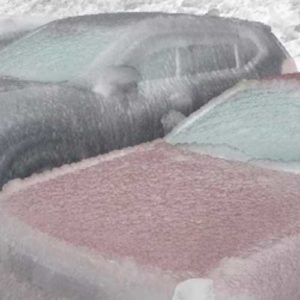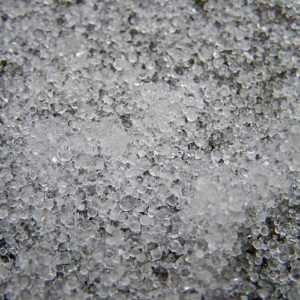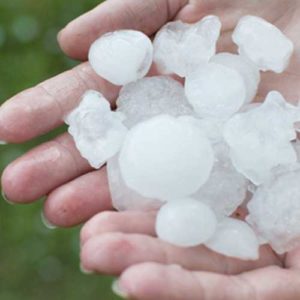Typically, we experience sleet in the wintertime months and hail during the warm months of summer – so why is it hailing in December?
While sleet and hail are both forms of frozen precipitation, they form in completely different ways but before we get further into these curious frozen weather phenomenons, let’s discuss all of the forms of precipitation.
There are five primary types that eventually reach the ground: snow, sleet, freezing rain, hail, and rain.
 Rain
Rain
When the air is warm enough all the way down to the earths surface, it’s just plain old rain. Further explained, when heat from the Sun turns moisture (water) formed from plants and leaves, as well as oceans, lakes, and rivers, into water vapour (gas), which disappears into the air. The water vapor then rises and turns into clouds.
When the water vapor cools and condenses, it then turns BACK into water. When the water droplets get too large and heavy to suspend, they fall as rain.
 Snow
Snow
Snow forms when tiny ice crystals in clouds stick together to become snowflakes. If enough crystals stick together, they’ll become heavy enough to fall to the ground.
Snowflakes that descend through moist air that is slightly warmer than 0 °C will melt around the edges and stick together to produce big flakes.
Snowflakes that fall through cold, dry air produce powdery snow that does not stick together.
Snow is formed when temperatures are low and there is moisture in the atmosphere in the form of tiny ice crystals.
 Freezing Rain
Freezing Rain
Freezing rain develops when warm oceanic air rises up and over the cold air, producing liquid precipitation that falls through the cold layer. The falling droplets become supercooled and freeze on impact with the cold surface causing freezing rain. Freezing rain is the precipitation type with the highest rate of accidents and death during the weather event.
Freezing rain occurs only when the earths surface is below freezing temperatures.
 Sleet
Sleet
Sleet is oftentimes confused with freezing rain but the two, in fact, are very different. Sleet is simply frozen raindrops and occurs when the layer of freezing air along the surface is thicker. This causes the raindrops to freeze before reaching the ground. Sleet isn’t as dangerous as Freezing Rain because instead of freezing when it hits the earths surface, sleet bounces off of objects on impact.
Sleet occurs when snowflakes only partially melt when they fall through a shallow layer of warm air. These slushy drops refreeze as they next fall through a deep layer of freezing air above the surface.
 Hail
Hail
Hail is essentially oversized sleet. Hail is frozen precipitation that can grow to very large sizes through the collection of water that freezes onto the hailstone’s surface.
Hail typically forms in spring, summer or fall thunderstorms. First, soft, snow-like particles form in subfreezing air at the top of a thunderstorm. (Yes, even in the middle of summer, the tops of thunderstorms are below freezing).
The hailstones grow bigger in the clouds as ice crystals and cloud droplets freeze onto them. They’re held suspended in the clouds by strong winds that push up into the storm.
Finally, once the hailstones grow too heavy, gravity causes them to fall to the Earth.
Hailstones come in a variety of shapes and sizes. They can be lumpy, bumpy, and may even take the shape of small spikes. Hailstones must be at least 0.2 inches in size.
Hail typically forms during the warmer months of summer.
Why are we seeing hail in the winter months?
As you have read above, you now know that the months in which hail forms doesn’t depend on seasons but the temperature of the season.
Hail requires cold in the upper atmosphere, where it forms. A raindrop forms and begins to fall, but an updraft takes it into the freezing zone, where it freezes. It begins to fall again, but another updraft takes it back up, where it acquires another layer of ice. After several such cycles, the frozen particles fall as hailstones. It may be cold or not so cold on the ground.
Typically, the winter months display cooler temperatures and the summer months are warmer. This isn’t always the case, much like we experienced in Kentucky this December of 2021.
The average temperature in Kentucky during the month of December is high 45.4°F and low 29.9°F. December 11, 2021 clocked in at a high of 66°F and low of 54°F.
On December 10, 2021, a violent, long-tracked tornado moved across Western Kentucky, producing severe to catastrophic damage in numerous towns. In Paducah, KY on December 11, 2021 – 2.75″ hail fell from the sky resulting in hail damage to vehicles and homes.
“The hail recorded earlier in the evening Sunday from the supercells ahead of the cold front was very impressive. Especially for the time of year. A few locations even observed hail damage to vehicles and homes. Ping pong ball sized hail was even observed by a NWS employee in the Paducah area.” – WPSD Local.
2021 has proven to be the year of record breaking and unseasonably warmer winter months….and unseasonable weather.
